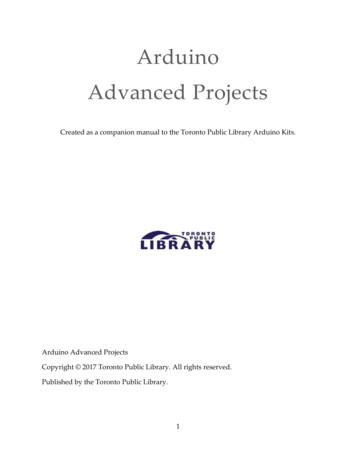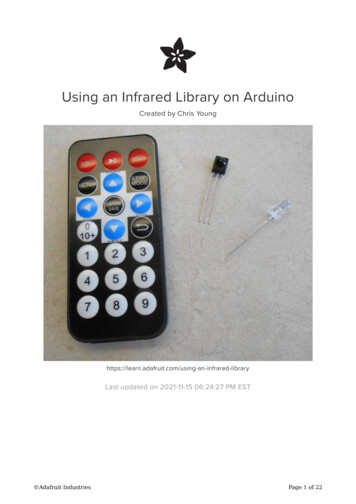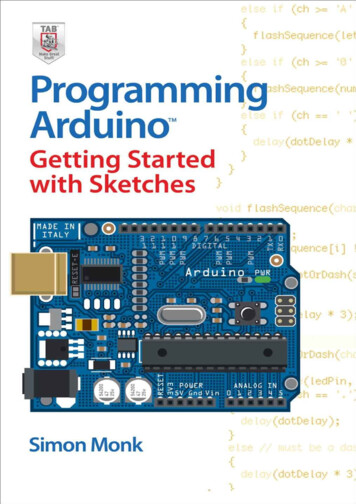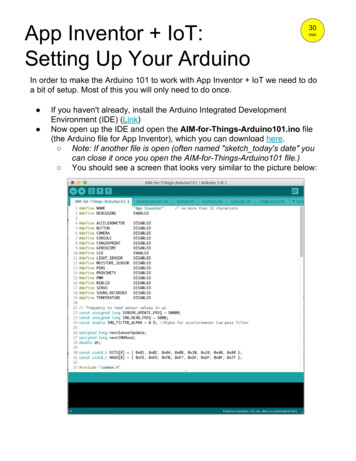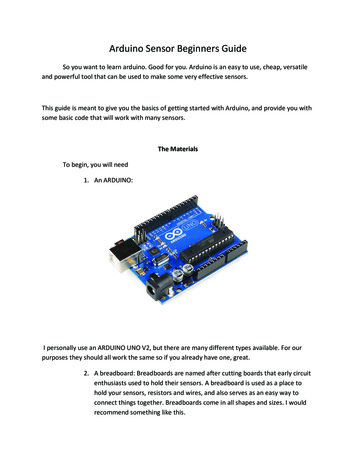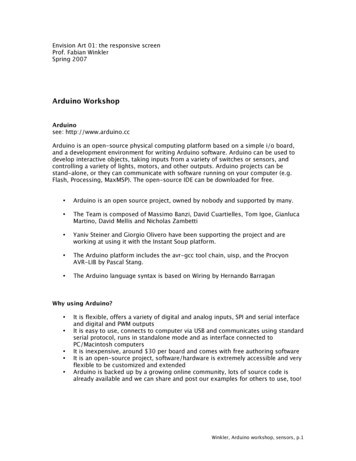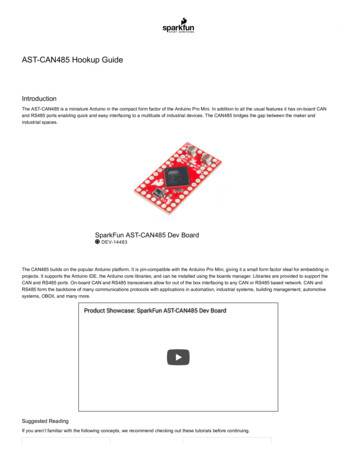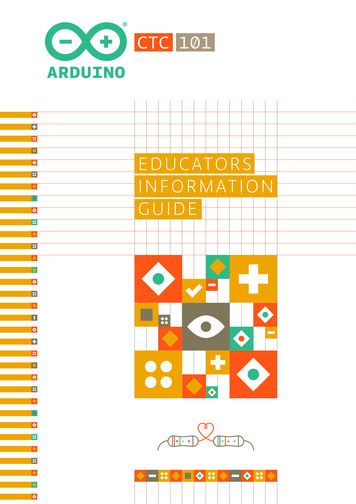
Transcription
EDUCATORSINFORMATIONGUIDE
TABLEOF CONTENTSArduino Education: Inspiring, Teaching and EmpoweringWhat is Arduino? 5The Education Team And Its Mission5Current Use Cases in Education5Features and Methodology 6What is CTC 101 7CTC Testimonials 9What it is included 10Toolbox 11Online Platform 12Educators Support and Resources 14CTC 101 JourneyPurchase 15Educators Training 17Implementation With Students 18Contact Us 19CTC 101 FAQ21
INSPIRINGTEACHING& EMPOWERING
ARDUINO EDUCATIONWHAT IS ARDUINO?Arduino is an open-source hardware, software and content platform with a worldwide community.Over the years, Arduino has powered thousands of projects, from everyday objects to complexscientific instruments.THE EDUCATION TEAM AND THE MISSIONArduino Education is a dedicated global team formed by education experts, content developers,engineers and interaction designers, focused on developing the next generation of STEAMprograms and supporting teachers and students needs throughout the educational journey.CURRENT USE CASES IN EDUCATIONEducational institutions use Arduino to:Develop: At universities, it is widely adopted in the fields of engineering, Internet of Things, robotics,art, and design, to name just a few.Teach and learn: Many secondary schools use it with innovative techniques for cross-curriculumstudies.Play: Primary schools use toys embedded with Arduino technology to introduce physical learning,logic, building skills, and problem solving.ARDUINO EDUCATIONARDUINO.CC/EDUCATION5
FEATURES AND METHODOLOGYArduino’s Immersive Educational Environment promotes the creative process through projectbased learning, with a focus on student interaction and group collaboration.“Back in 2012, I was given the challenge of bringing project-based learning to myfirst group of upper secondary schools in Spain. I realized at the time that almost noone was addressing the needs of educators when introducing curriculum. Therefore,I decided that we had to put educators at the center of our concept and help themfind creative ways for using technology. Arduino Education is not just about makinginteresting projects with students, it is also about getting acquainted with developingtechnologies and new methods of teaching.” - David Cuartielles, Arduino co-founder6ARDUINO EDUCATIONARDUINO.CC/EDUCATION
WHAT ISCTC 101?Creative Technologies in the Classroom 101, or CTC 101, is a modular STEAM (Science, Technology,Engineering, Arts, and Mathematics) program, tailored for students ages 13 to 17. It is the flagshipArduino Educational Program for schools.CTC 101 uses “project-based” learning methodology. Students are introduced to the foundationsof programming, electronics, and mechanics through a series of playful, well-documented projectsand easy-to-assemble experiments.ARDUINO EDUCATIONARDUINO.CC/EDUCATION7
PROVEN MODELIt has been tested globally with excellent results:735SCHOOLS1 550EDUCATORS17 700STUDENTS1 720PROJECTS90%STUDENTS WANTED TO LEARN MOREABOUT PROGRAMMING90%EDUCATORS FELT THAT THE PROGRAMMEEXCEEDED THEIR EXPECTATIONS70%EDUCATORS LEARNED PROGRAMMINGTHROUGH THE CTC TRAINING8
CTC TESTIMONIALS"CTC is one of our best examples of educational activities and makes us especially proud on accountof its potential for teacher training, student motivation, and transformation of the society in whichwe live."Javier Hidalgo, Head of Exhibitions and Programmes, la Caixa Foundation"The CTC program, through its didactic proposal based on creative technologies, has providedimportant input to learning through problem solving, and the application of computationalthinking and teamwork, key aspects for the development and achievement of key competencesfor the citizen of 21st century, among which is there is also how learning to learn. "Rosanna Fernández, Program Coordinator, Center of Educational Resources Specific Support toInnovation and Educational Research, Catalonia, Spain“It was new, interesting and educational. The students appreciated Arduino, and the interest iswide among students and teachers alike.”Teacher, CTC Kreatech, Skåne Sweden"[CTC] It's a great way to get started with programming, electronics, and automation — thisprogram is so entertaining and fun that it does not seem like you're taking a class — all classesshould be as interactive and constructive just like these!”Joel Borja Tomàs, Student, Institut de Tecnificació, Amposta, SpainARDUINO EDUCATIONARDUINO.CC/EDUCATION9
WHAT'S INCLUDEDA toolbox with 26 playful projects and easy toassemble experiments.An online platform with well-documented step-bystep instructions.Educators guidance, including training, live webinarsand forum monitoring by Arduino Education experts.TOOLBOX2 6 P R O J E C TSA N D E X P E R I M E N TSB O A R D S, SH I EL D S A N DCO MP O N EN T S F O R A C L A SSO F U P TO 3 0 ST U D EN T SONLINE PLATFORME N G / S PA / I TA /C ATCO N TE N TP R O J EC T B A SEDL EA R N I N GTEACHER SUPPORTG U I DE D E DU C ATO R S T R A I N I N G , L I V E W EB I N A R S,A N D M O N I TO R E D F O R U M BY A R D U I N OE DU C ATI O N E X P E R T S10
CTC TOOLBOXEach toolbox contains enough boards, shields and components for a class of up to 30 students, andfor the educators to get trained:6 Arduino 101 boards: One of the most powerful Arduino boards for education, includingwireless communication (Bluetooth) and an integrated IMU (Inertial Measurement Unit). They areprogrammable, able to read inputs (e.g., light levels on a sensor), and capable of controlling outputs(e.g., activating a motor).6 Arduino Education Shields: Add-on boards that connect to the Arduino 101s to extend theirfunctionality. The Education Shield is a custom-made shield designed by Arduino Education,specially tailored for educational purposes to enable quick and easy learning when building projects.10 mini breadboards: Used to make circuits easier to build. They can be either attached on top ofthe Education Shield or used separately to connect other components.Set of electronic components: Used to create interactive electronic circuits. Includes resistors,potentiometers, LEDs, push buttons, capacitors, and diodes.Set of plug and play modules: Sensors and actuators equipped with all the necessary componentsonboard, so they can be directly connected to the Education Shield. Modules include a joystick,light and tilt sensors, and an infrared array.Set of sensors and actuators: Includes light, knock, touch/capacitive, and infrared sensors, as wellas actuators like standard and continuous servo motors.Set of batteries: Includes both 9V and 1.5V batteries, and 4-slot and 8-slot battery holders.Media and storage: Includes webcam, SD card and a speaker. The Education Shield has an SD cardreader and an audio connector.Set of cables: Includes all the necessary cables, such as USB cables, jumper wires, module cables,battery snaps, alligator cables, and single core wires.MDF parts: These laser-cut MDF parts can be used to build more than 10 different projects.Storage and sorting boxes: Electronic components can be sorted inside these boxes, based ontheir functions and sizes. After MDF parts are removed from their frames, they can be stored forlater use in the resealable storage bags. The sorting box with dividers can be used to organizesmaller components.ARDUINO EDUCATIONARDUINO.CC/EDUCATION11
CTC TOOLBOX12
ONLINE PLATFORMCTC 101 is built on its own Education Learning Management System (LMS) with step-by-stepinstructions and lessons based on five themed modules:Module 1: Programming and basic codingModule 2: Arduino boards and digital signalsModule 3: Analog signals and serial communicationModule 4: Robotics, power systems, and motorsModule 5: Wireless communication via Bluetooth and advanced sensorsMoreover, the platform has a:An educators section with self-administered online training, materials for class preparation,guides, and other resources.A reference section with additional material and exercises for troubleshooting and furtherlearning.ARDUINO EDUCATIONARDUINO.CC/EDUCATION13
Users receive access to the online platform for a year. Up to three educators and 30 students aregranted access. Educators can then add/remove students to/from the platform at any time withinthat year.The content on the online platform helps students get started with programming and electronics,while building fully-functional, interactive projects under the guidance of educators. The contentis currently available in English, Spanish, Italian, and Catalan.Educators are granted access before students so they can prepare and adapt their lesson planswith more engaging and creative techniques. This allows them to take full advantage of the latesttechnologies and integrate them into their curriculum.The content and class dynamics are specially designed to enhance the students’ problem solvingand teamwork skills in a collaborative environment.EDUCATORS SUPPORT AND RESOURCESThe Arduino Education team is committed to providing support and solving potential challenges aseducators teach CTC 101 content and guide their students through new projects.Educators support includes:Dedicated online communication with the Arduino Education team every step of the way—purchasing advice, online platform access, student enrollment, and any additional questionsregarding CTC 101 deployment in the classroom.An onboarding live webinar where educators will go through the program’s features and thetools available on the online platform, as well as receive recommendations on implementing CTC101 in the classroom.Access to a moderated forum that allows CTC 101 educators to share their knowledge andexperiences with other educators from around the world.Self-administered training, which consists of video tutorials and other training content foreducators to complete at their own pace. There are five training sections per CTC 101, one for eachmodule, with an auto-evaluation test at the end.Live training webinars led by Arduino Education experts, which provide educators with theopportunity to ask questions in real-time. There are five self-administered sessions with threeavailable booking options per day.Live Q&A webinars to assist educators with any difficulties that arise during the implementationphase. There are ten sessions in total, all led by Arduino Education experts.14ARDUINO EDUCATIONARDUINO.CC/EDUCATION
CTC ITH STUDENTSUpon purchasing the CTC 101 program, the toolbox will be shipped and the educators will betrained in order to implement the program with their students.PURCHASEThe CTC 101 program can be purchased from the official Arduino Store (STORE.ARDUINO.CC/ARDUINO-CTC-101-PROGRAM ) and selected Arduino Education resellers. We recommendyou allocate enough time between purchasing the program and starting the implementation, sothat educators (up to three) can be properly trained. Please refer to page 17 (Educators Training).There are two main CTC 101 packages:WHAT’SINCLUDEDFULLSELFLEARNINGCTC 101TOOLBOXYesYesONLINE PLATFORM1-YEAR ACCESSYesYesDEDICATEDONLINE COMMUNICATION WITHARDUINO EDUCATION EXPERTSYesYesONBOARDINGLIVE WEBINARYesYesACCESS TOA MODERATED FORUMYesYesSELF-ADMINISTEREDTRAININGYesYes5 x LIVE TRAININGWEBINARSYesNo10 x LIVE Q&AWEBINARSYesNoPRICE 1,750 1,350Furthermore, there are additional packages for training, support, and online platform access.15
ADDITIONAL PACKAGESOPTIONALMODULESTRAININGSUPPORTTRAININGAND SUPPORTONLINE PLATFORM1-YEAR ACCESSNoNoNoYesDEDICATEDONLINE COMMUNICATION WITHARDUINO EDUCATION EXPERTSYesYesYesNoONBOARDINGLIVE WEBINARYesYesYesNoACCESS TOA MODERATED No5 x LIVE TRAININGWEBINARSYesNoYesNo10 x LIVE Q&AWEBINARSNoYesYesNoPRICE 250 500 550 100EXTENDED ACCESSTO THE PLATFORMNote that additional packages can only be purchased if full or self-learning packages has been purchasedbefore. Training and support packages can be purchased only while having access to the online platform.Extended access to the online platform can be online purchased within the first year after the firstpurchase.Each CTC 101 toolbox contains six Arduino 101 boards for educators to divide evenly among the class,so each group of students has one. The table below shows three different scenarios based on thenumber of students per class. 1,750CTC 101 - Full package16Students per Class182430Students per Group*3(Recommended)45(maximum)Cost per Student** 97 73 58** Considering 30 students within a year period
EDUCATORS TRAININGAll training content, video tutorials, and auto-evaluation tests are included with the online platform.HOW MUCH TRAINING TIME DO EDUCATORS NEED?LEVELLEVELINDICATORHOURS TOCOMPLETE TRAININGBEGINNERNew to Arduino, electronics,and programming. First timeimplementing a STEAMprogram.30 INTERMEDIATEModerate understanding ofArduino, basic electronics, andprogramming concepts.Familiar with STEAM programs.15-20ADVANCEDExtensive knowledge ofArduino, electronics, andprogramming. Haveimplemented at least oneSTEAM program.10-15Educators can choose between guided (included in the full package) or self-administered training:Self-administered training: Educators can go through video tutorials and training content on theirown. There are five training sections per CTC 101, one for each module, with an auto-evaluation testupon completion.Guided training: Self-administered training plus five live webinars with Arduino Education experts.During these webinars, educators will walk through the CTC 101 content with a member of theArduino Education team.Both options include a certificate for educators. Once educators have completed each of theauto-evaluation tests, they can download the certificate directly from the online platform.During the training, educators will learn how to:Get started with programming and electronicsAdapt their lesson plans with engaging and creative techniquesTake a hands-on approach to achieving defined learning objectivesImplement STEAM programs within the classroomARDUINO EDUCATIONARDUINO.CC/EDUCATION17
IMPLEMENTATION WITH STUDENTSAfter purchasing the program and becoming trained, the CTC 101 program will be implemented tostudents. Students will go through the five themed modules in the online platform, while buildingexperiments and projects using the classroom toolbox.HOW LONG DOES THE CTC 101 PROGRAM TAKE WITH STUDENTS?CTC 101TIMELINENUMBER OFCONTENT MODULES5LESSONSPER MODULE5LESSONSIN TOTAL25HOURSPER LESSON1HOURSIN TOTAL25At the end of the course, students will have the opportunity to design their own projectsand share them with the Arduino Education community. Educators will adapt the number oflessons available for these projects based on their own class plans and curriculum.During the implementation, students will:Learn programming and basic Arduino codingExplore digital and analog signals to build fully-functional and interactive projectsBe introduced to robotics, power systems, and motorsCreate their first IoT devices with Bluetooth connectivityEnhance their problem solving and teamwork skills in a collaborative environment18ARDUINO EDUCATIONARDUINO.CC/EDUCATION
CONTACT USPurchase the CTC 101 arn more about Arduino Education:ARDUINO.CC/EN/MAIN/EDUCATIONSend your CTC 101 questions:CTC.101@ARDUINO.CCARDUINO EDUCATIONARDUINO.CC/EDUCATION19
CTC 101FAQCAN AN ORGANIZATION OR COMMUNITY GROUP RUN THE PROGRAM?CTC 101 program is primarily aimed at schools, but any group interested in exploring STEAMdisciplines can run it.WHICH CTC 101 PACKAGE DO YOU RECOMMEND?If it is the first time that an organization, school, or educator is purchasing CTC 101, we recommendselecting the full-package.If a school already has a CTC 101 program but the educator has never implemented the program,we recommend you purchase the training and support packages, either together or separately.If the school wants to run a CTC 101 program and the educator is properly trained, the self-learningpackage is a good choice.IS IT NECESSARY TO BUY ANOTHER TOOLBOX OR ADDITIONAL MATERIALSFOR THE EDUCATORS TRAINING?No, educators will be trained using the same materials that their students will use later on. The CTC101 toolbox contains all of the materials needed for educators training.WHAT ARE THE MINIMUM REQUIREMENTS IN THE CLASSROOM?Schools running the CTC 101 program should have student access to computers with Internet access(at least one computer for three students), a dedicated room that can function as a workshop (orat least a room with tables), and common accessories such as pens, scissors, sticky tape, etc.HOW EDUCATORS CAN GET AN EXTRA YEAR ACCESS TO THE ONLINE PLATFORM?Users receive access to the online platform for a year. Up to three educators and 30 students aregranted access. Educators can then add/remove students to/from the platform at any time withinthat year. There is an additional package (extended access to the online platform) that allowsaccess to another 3 educators and 30 students for an additional year.ARDUINO EDUCATIONARDUINO.CC/EDUCATION21
NOTES
NOTES
ARDUINO.CC/EDUCATION
6 Arduino 101 boards: One of the most powerful Arduino boards for education, including wireless communication (Bluetooth) and an integrated IMU (Inertial Measurement Unit). They are programmable, able to read inputs (e.g., light levels on a sensor), and c




